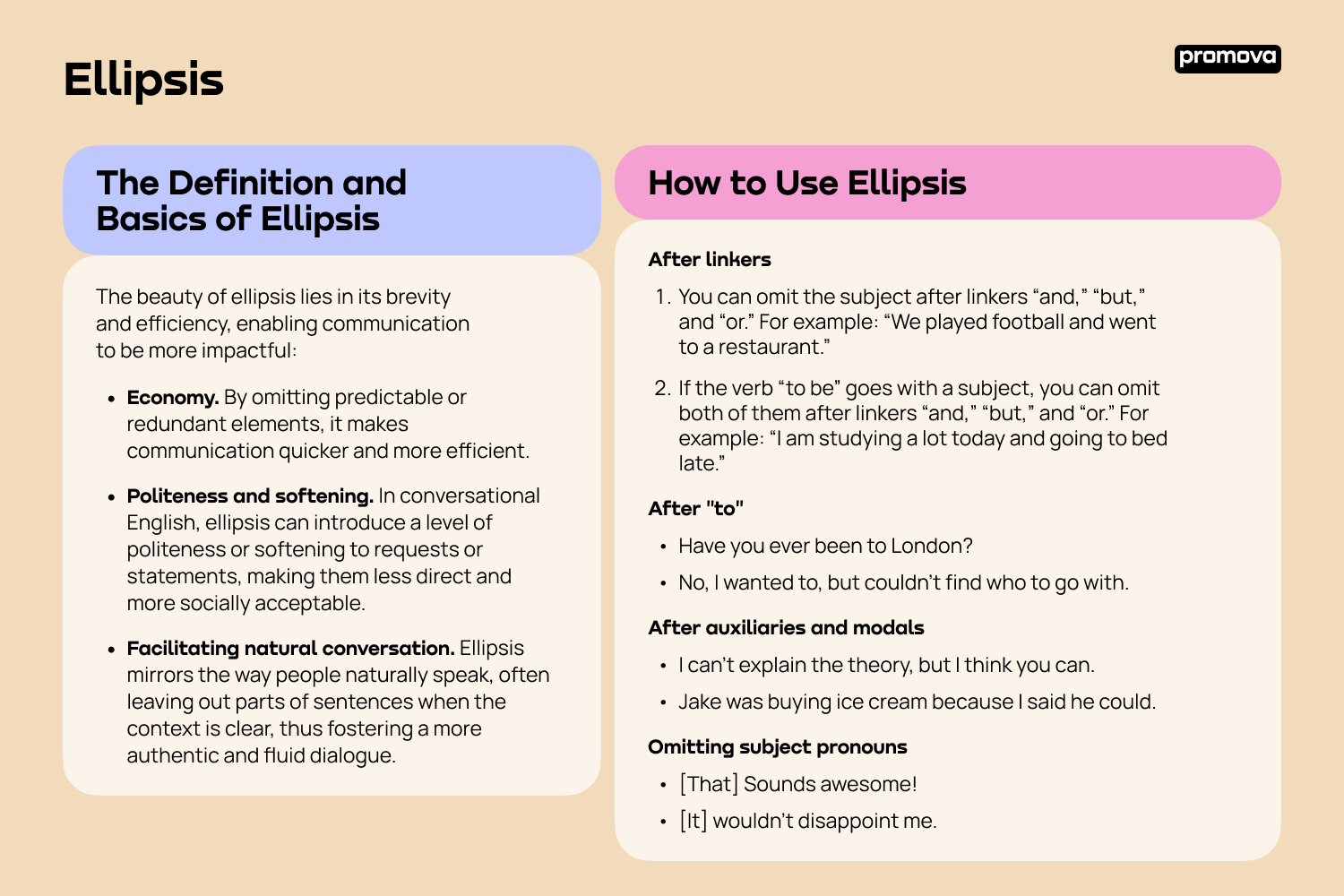Ellipsis
Contents
Ellipsis is a linguistic device that holds significant power in both written and spoken English. It helps to leave the words out without losing the sentence's meaning or spoiling the grammatical structure. In this article, you will delve into the meaning of ellipsis, explore its various roles, and understand how it enhances our language.
The Definition and Basics of Ellipsis
Ellipsis, at its core, involves omitting parts of a sentence without causing any loss of meaning. This linguistic strategy relies on the context and the reader's or listener's ability to infer the missing information. The beauty of ellipsis lies in its brevity and efficiency, enabling communication to be more impactful:
- Economy. By omitting predictable or redundant elements, it makes communication quicker and more efficient.
- Politeness and softening. In conversational English, ellipsis can introduce a level of politeness or softening to requests or statements, making them less direct and more socially acceptable.
- Facilitating natural conversation. Ellipsis mirrors the way people naturally speak, often leaving out parts of sentences when the context is clear, thus fostering a more authentic and fluid dialogue.
To effectively use ellipsis, you must understand the context and ensure that the omission does not lead to ambiguity or confusion. It's crucial to strike a balance, using ellipsis to enhance clarity and impact rather than detracting from the message.
How to Use Ellipsis
When used correctly, ellipsis can help you to communicate effectively. At the same time, it may significantly spoil the message if used mistakenly. So it’s necessary to understand how and when to use the ellipsis in English.
After linkers
Linkers, or transitional words/phrases, guide from one idea to another, ensuring cohesion. When an ellipsis is used after a linker, it suggests that the word or idea was already mentioned and shouldn’t be repeated once again.
- You can omit the subject after linkers “and,” “but,” and “or.” For example: “We played football and went to a restaurant.”
- If the verb “to be” goes with a subject, you can omit both of them after linkers “and,” “but,” and “or.” For example: “I am studying a lot today and going to bed late.”
Remember that you can’t omit the words after linkers “because,” “before,” “after,” “when” and “while.”
2
After "to"
In dialogues, you can often omit the repeated phrases if they’re clearly understandable without mentioning them. For example:
- Have you ever been to London?
- No, I wanted to, but couldn’t find who to go with.
Such an approach helps to develop a more natural speech flow. Communicating like this, you will sound like a proficient English speaker.
After auxiliaries and modals
Auxiliary verbs ("be," "have," "do") and modal verbs ("can," "might," and "should") are crucial for constructing various verb tenses and expressing nuances of mood or ability. An ellipsis following these verbs can indicate an intentional omission of the repetitive phrase, often for the sake of brevity or when the action is understood from the context:
- I can’t explain the theory, but I think you can.
- Jake was buying ice cream because I said he could.
The ellipsis suggests that the reader can perform or understand the implied action without explicitly stating it.
Omitting subject pronouns
In informal writing or dialogue, ellipses can be used to omit subject pronouns when the context implies them:
- [That] Sounds awesome!
- [It] wouldn’t disappoint me.
This stylistic choice can mimic spoken language, where brevity or casualness allows for such omissions.

Conclusion
To use ellipsis correctly, always focus on clarity. If the omitted information is either obvious from the context or unnecessary, you can use ellipsis. Remember to adjust the use of ellipses according to the formality of written or spoken communication. By embracing this powerful tool, you can communicate more effectively.
Comments